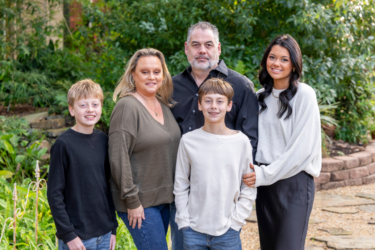“When human beings lose hope, we also lose purpose. But when we find purpose, we can find hope, and when we find hope, I truly believe it can help us stay here. If we see the light at the end of the tunnel and that the struggle is all for something greater, we can find that hope, hold on to it, stay here, and be here tomorrow,” Kevin Hines proclaims.
In 2000, Kevin was in a place of extreme darkness. Struggling with bipolar disorder, he succumbed to the dark voices that convinced him to take his own life. He climbed over the railing of the Golden Gate Bridge and plunged to what he thought would be his death. He says he regretted his choice immediately. Plummeting 25 stories in four seconds, Kevin slammed into the San Francisco Bay, but survived, joining only 35 other survivors out of 2,000 who have taken the same jump.
Kevin began telling his story just seven months after that plunge into the Bay, and he has not stopped. He travels the globe speaking about suicide prevention and brain health, working tirelessly to assure everyone he can that they have value and deserve to be here tomorrow. “It’s been 17 years of speaking out about living with this disease and fighting to stay well, having the symptoms I’ve always had, but being able to maintain and manage them with a routine and regimen of mental health care and well being,” says Kevin. He and his wife, Margaret, have formed a nonprofit social impact organization called CNQR that aims to drive large scale change in the brain health and wellness space as a means to ultimately eradicate suicide. Their mission is to convince the world that “brain health is for everyone,” Kevin explains. “We are in the opinion that brain health and mental health should be taught from fourth grade on up so they can learn how to keep their brains stable with common sense tools that can help anyone manage and maintain positive brain wellbeing. If we’re going to change a generation and their attempts at suicide, we have to get to them at a very young age, so they grow up knowing that suicide is not an option. We want them to have the ability to find resilience in the face of darkness and the ability to find hope so it can help heal.”
Part of the CNQR crusade is to teach others that brain health is a necessity and to dispel the stigma surrounding mental health issues. “A brain disease is just like any other organ disease, but it’s just something that we don’t see the pain or the struggle. It’s not a cast on the arm that everyone notices. We can’t fathom that it’s real, yet it’s the most real. Your brain is the single most powerful organ you have. It’s mostly on automatic mode, but it’s also controlling every action you take, every decision you make, and in a sense, every other organ in the body. Yet, we don’t look at brain health as part of our everyday activity or lifestyle.” Just as we schedule time for the gym to take care of our bodies, we should also schedule self care for our brains. Kevin does not just preach this message, but lives it out devotedly. Margaret speaks of her husband’s determination to stay healthy, “Kevin is very self aware, very self-disciplined, and he is seriously the one person in my entire life that wants his wellness more than anyone else. He fights for it. Watching him fight for his wellness on a daily basis is also inspirational for me because it makes me want to help him stay at that pinnacle of successful health.” Kevin credits his wife, in turn, by saying that she is what keeps him healthy. He shares that her compassion and empathy have helped them fight his mental health battles. “These symptoms never go away. They’re a part of my life, our lives. We understand that the episodes are going to come, and we have to get through them together and together we can and together we will.”
A strong support system goes a long way for a person struggling with mental health and thoughts of suicide. You can be that support for a friend or family member that needs the reminder to be here tomorrow. Parents, it is critical that you listen to your children and allow them to speak their pain. In Kevin’s many presentations to schools, he shares that young people come up to him and say that they “have been diagnosed with A, B, or C, but mom or dad don’t believe it’s real. They go to school and they’re validated in their pain, but they go home and that same pain is invalidated. Or, their parents may know they are seeing a doctor or therapist, but they don’t know that the young person is struggling a great deal more than they are letting on, which is what I ended up doing to my own dad. So they silence that pain or bury it.” This silence leads to dangerous places. He wants those young people to know that “recovery is legitimate, but you have to know who to turn to, where to go, and how to ask for help.” This is where all of us can step in to be a positive bridge for one another.
For Kevin, the bridge is a powerful symbol of a second chance, a new chance to live life to the fullest. Many of us drive across the Mississippi River Bridge frequently, but how many times have you thought of yourself as a possible bridge for someone else to get to a second chance or a healthier life? Kevin shares, “You can be a bridge to finding hope, health, and healing by reaching out with total lack of judgement for what they’re going through, keeping eye contact that is cool, calm, and collected, and understanding that although you don’t know what they’re going through, you can empathize. The first step to take is reach out to that person personally and say I’m worried about you and here’s why. I do care and I want you to be safe. The next step is if you have an inclination that this person is suicidal, ask the questions, ‘Are you suicidal? Have you ever made plans to take your own life?’ If they happen to be, you’ve just given them permission to talk about their pain like no one else has. Then, get an adult or parent or person in authority involved to make sure that person is safe that day and moving forward. Put yourself in their shoes and recognize that brain health, brain dysfunction, and brain instability comes from misfiring chemistry in one’s brain. Look at them with understanding and empathy and say, ‘I’ve got your back, and whatever you need from me, I’ll be there without judgment. I will walk with you to services or help.’”
Kevin can say all this because he lives it. And he believes telling his story will continue to impact others. “Storytelling saves lives, and now we’re finding science is backing that up. We’re finding out that there are neurons and chemicals in the brain that light up when a story like mine is told about recovery. We’re finding that these stories of recovery can transform a person’s life. I have received thousands of letters saying that I changed someone’s life, but I believe that I sparked a piece of the brain that helped that person stand up when they were in two feet of water drowning and say, ‘I’m going to fight for myself,’ and then they do the work to save their own lives,” Kevin says. His story, though graphic, contains recovery and hope. “The most important part of his life is what happened after his attempt. He has such a healthy and happy life now,” says Margaret. But that healthy and happy life comes with a great deal of Kevin’s effort. He shares, “It’s definitely a journey. It’s a process. It’s about working tirelessly to better your brain health. Depression is the greatest liar that we have ever known. Depression will lie through its teeth to get you to hurt yourself or someone else. When in reality, your thoughts do not have to become your actions. Your thoughts from depression do not have to own or define you or rule the day. You can beat your thoughts. Your thoughts of suicide do not have to become your actions and destroy your life.”
If anyone is thinking of suicide, text “CNQR” to 741 741, the Crisis Text Line.
Or call the National Suicide Prevention Lifeline – 1-800-273-8255




